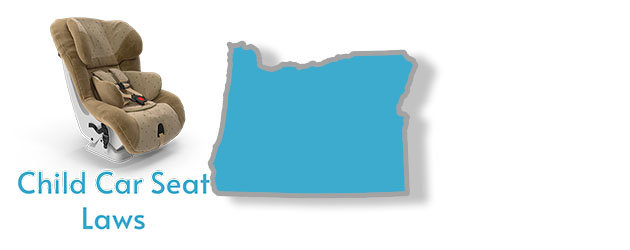A Summary of Child Car Seat Laws in Oregon
- Oregon law requires children to ride rear-facing until age 2.
- Once children reach the age of 2 or outgrow the rear-facing seat, they are allowed to graduate to a forward-facing seat.
- The law requires children over 40 pounds or those who have outgrown forward-facing seats to ride on booster seats until they are 8 years old or 4’9’’ tall.
- Rear-facing seats should never be placed in the front seat when there is an active airbag.
- Children should ride in the back seat until age 13.
Rear-facing Car Seat Laws in Oregon
Oregon law requires children to ride rear-facing until age 2. According to the AAP (American Academy of Pediatrics) children should remain rear-facing for as long as possible or until the manufacturer’s weight and height limits have been exceeded. The reason for this is because the rear-facing position offers the best protection for children as the back of the seat absorbs most of the impact forces, thus protecting the child’s delicate body parts (neck, spine, and head). Parents can start by using an infant-only seat when the child is still a newborn, and then transition to a convertible seat when the child gets bigger. Convertibles have higher weight limits (up to 40 pounds) and this allows infants to remain rear-facing until age 4 depending on their growth rate. Rear-facing seats should be installed in the back seat according to the manufacturer’s instructions.
Forward-Facing Car Seat Laws in Oregon
Once children reach the age of 2 or outgrow the rear-facing seat, they are allowed to graduate to a forward-facing seat with a harness. The law also requires children to remain in this type of seat until they attain a minimum weight of 40 pounds. Parents with convertible seats can turn their seats to face forward and those without can opt for a forward-facing only seat. A seat with a 5-point harness should have 2 shoulder straps, a crotch strap, and two hip straps. The straps must be snug over the child’s body and also be fastened according to the manufacturer’s instructions. Correctly installed harness straps help in distributing crash forces away from the fragile body parts of a child and across the more developed parts of the body (shoulders and hips). Most seats can support up to 65 pounds, so this means some kids can remain forward-facing until age 7. Forward-facing seats can be installed with either a lap belt or lap-shoulder belts. Seats of this type should also be placed in the back seat and away from an active airbag.
Booster Seat Regulations in Oregon
The law requires children over 40 pounds or those who have outgrown forward-facing seats to ride on booster seats until they are 8 years old or 4’9” tall. A booster seat is designed to help a regular seat belt fit over a child’s body. The height of the booster seat helps keep the shoulder belt snug across the chest and the lap belt flat across the upper thighs. Without the booster seat, the belt straps can lie across the stomach and neck, and this can cause serious injuries in the event of an accident or an abrupt stop. There are two types of booster seats – high-back and backless. A high-back is mainly used to support a child’s head and neck when a headrest is not available while a backless booster seat is preferable when the back seats are equipped with headrests. Booster seats can support up to 80 pounds, so some children can still use them even up to age 10-12 years. When it comes to transitioning to seat belts, most experts encourage parents to focus on the child’s height rather than weight or age. This is because seat belts are designed for people 4’9” or taller, so anyone shorter may not fit in safety belts. Children who are seat belt ready should also be able to sit all the way back against the seat without slouching, and with knees bent over the edge of the seat, and feet should touch the floor. Also, the child should be able to ride without trying to detach the seat belt.
Requirements for children to use the front seat in Oregon
The state does not have an official law that prohibits certain children from sitting in the front seat. However, the state says rear-facing seats should never be placed in the front seat when there is an active airbag as this would violate the state’s directive of proper use of a child safety seat. According to the AAP, the back seat is generally safer for children, and they should remain there until age 13.
Law on leaving a child in a car in Oregon
There is no law regarding leaving a child unsupervised inside a car. It is not recommended to leave you child unattended in a vehicle for any length of time.
Law on Smoking in a car with a child in Oregon
It is illegal to smoke in a car with a child passenger under the age of 18 years.
Car Seat Law Exemptions in Oregon
Oregon safety belt law requires occupants of commercial vehicles such as taxis and limousines that are transporting fewer than 16 people to use safety restraints. Taxicab drivers are the only ones exempt from complying with this rule.
Law on Car Seat Replacement in Oregon
The state does not have any laws regarding car seat replacement. According to the National Highway Traffic Safety Administration, car seats should be replaced after a moderate or severe accident. Car seats usually have expiry dates (about 6 years), so be sure to check yours.
More Oregon Laws
